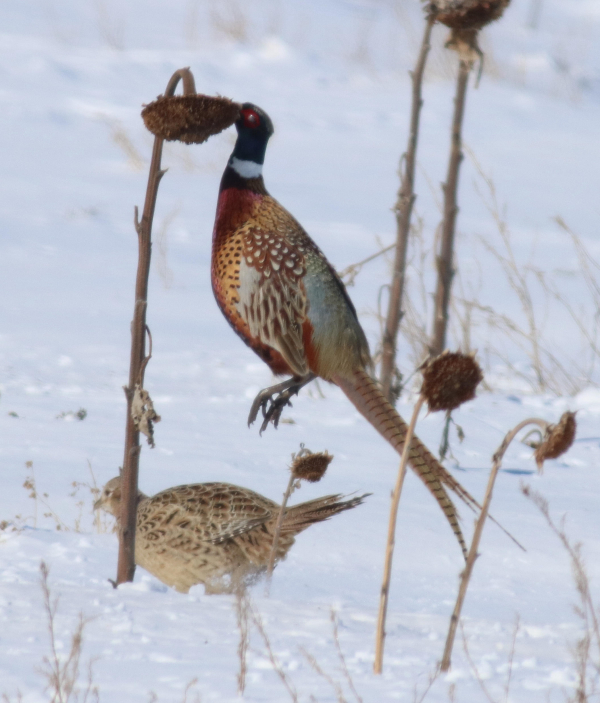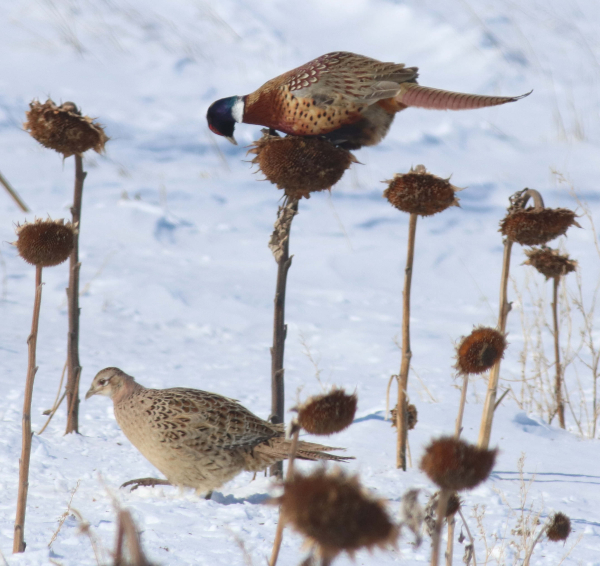Editor’s Note: Today’s field report is from our Birding Wire editor Paul Konrad. If you’re a birding enthusiast and aren’t already receiving our weekly Birding Wire, you should hie yourself over there right now (www.birdingwire.com) and sign on for the birding industry’s largest and most frequent source of original content.
During my SoDak field trip last week, I was alerted to a scattered flock of Ring-necked Pheasants feeding on the seeds of some unharvested, rather stunted sunflower heads. The thing that made this feeding effort unique, at least for me, was that because the sunflowers were still on their stalks, and because the stalks were only a couple feet above the snow, the pheasants were able to stretch upward to reach some seed heads to knock down seeds. As seeds dropped to the snow-covered ground, pheasants positioned nearby rushed in to collect as many seeds as they could.

Even more interesting was that other taller sunflowers could only be reached by jumping upward a foot or so, followed by a similar rush to gather seeds. This “new” behavior was interesting to watch, and I quickly reacted by documenting the action with my camera. Then the Ring-necks really surprised me! Some of the pheasants jumped on top of the drooping sunflower heads, balanced there, then pecked at the inverted seed head from above. This was not an easy task, as the pheasants needed to balance on the unsteady dried sunflower plants, while reaching over and beneath the seed head to reach the sunflower seeds.
While the unique feeding process is difficult to explain in writing, my resulting photographs illustrate the process quite well. The photos also document what some people might not fully understand, or might even question, without proof. Similarly, by documenting a bird with a photo or two, you can often gain some a better view of a rare or unusual sighting. Even the identification of a bird can be aided by photographs when the species, age, or sex may not be as obvious as you would like in the field.

Case in point, while observing and photographing a perched Bald Eagle last Thursday, I looked up to see a dark hawk flying toward my position. I quickly repositioned my camera and photographed the hawk as it flew by. My initial impression was that the bird was a dark morph Rough-legged Hawk, but the bird was not a chocolate brown color, but more of a medium-brown speckled coloration.
Only when I studied my photos of the bird, enlarged on my laptop, was it was evident that this was actually an immature dark morph Harlan’s Red-tailed Hawk. This was a plumage I very rarely see, and it was next to impossible to make a positive I.D. in the field. By reviewing the photos, the shapes of the head and bill were indicative of a Red-tail; and the bird’s plumage, when studied at leisure with the aid of field guides, showed it was a first-year dark morph Harlan’s Red-tail.

The value of using a camera, in addition to your binoculars and spotting scope, is without question a useful birding tool for documenting observations and assisting in verifying IDs, in addition to providing the excitement, fun, and satisfaction you gain from the photography aspects of birding.
Article and photographs by Paul Konrad
Share your bird photographs and birding experiences at editorstbw2@gmail.com